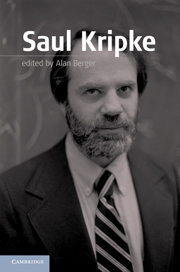Book contents
- Frontmatter
- Contents
- List of Contributors
- Introduction to Kripke
- Part I Naming, Necessity, and Apriority
- Part II Formal Semantics, Truth, Philosophy of Mathematics, and Philosophy of Logic
- Part III Language and Mind
- 9 Kripke’s Puzzle about Belief
- 10 A Note on Kripke’s Puzzle about Belief
- 11 On the Skepticism about Rule-Following in Kripke’s Version of Wittgenstein
- 12 Kripke on Color Words and the Primary/Secondary Quality Distinction
- Part IV Philosophy of Mind and Philosophical Psychology
- Index
- References
12 - Kripke on Color Words and the Primary/Secondary Quality Distinction
Published online by Cambridge University Press: 05 June 2012
- Frontmatter
- Contents
- List of Contributors
- Introduction to Kripke
- Part I Naming, Necessity, and Apriority
- Part II Formal Semantics, Truth, Philosophy of Mathematics, and Philosophy of Logic
- Part III Language and Mind
- 9 Kripke’s Puzzle about Belief
- 10 A Note on Kripke’s Puzzle about Belief
- 11 On the Skepticism about Rule-Following in Kripke’s Version of Wittgenstein
- 12 Kripke on Color Words and the Primary/Secondary Quality Distinction
- Part IV Philosophy of Mind and Philosophical Psychology
- Index
- References
Summary
The Lockean Primary/Secondary Quality Distinction and Kripke’s Reaction to It
Many philosophers, especially since the seventeenth century, have thought that the sensible properties of objects divide into two very different kinds. For these philosophers, determinate properties of color, sound, heat or cold, taste, and smell are in a way subjective or less real than properties such as solidity and determinate shape, motion and mass. In the seventeenth century, in particular, arguments for this divide played a role in defenses of the superior objectivity of the new physics, which was formulated in terms of properties of the latter group. In his influential treatment, Locke proposed that properties of color, sound, and so on are merely “powers to produce various sensations in us” (Essay Concerning Human Understanding, II.viii.10), dispositions that an object has to produce certain sensations in humans; he called these dispositions secondary qualities. He also postulated that solidity, the shapes, and so on are nondispositional, or primary qualities. Thus, for example, on Locke’s view, an object’s being yellow consists in its power or disposition to produce sensations of yellow, not in any intrinsic causal ground of that power. On the other hand, an object’s being spherical is an intrinsic property of it, different from its disposition to produce sensations of spherical shape in us under some circumstances, or from any other disposition it may have.
- Type
- Chapter
- Information
- Saul Kripke , pp. 290 - 324Publisher: Cambridge University PressPrint publication year: 2011
References
- 4
- Cited by



